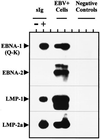Tonsillar memory B cells, latently infected with Epstein-Barr virus, express the restricted pattern of latent genes previously found only in Epstein-Barr virus-associated tumors
- PMID: 11035774
- PMCID: PMC17327
- DOI: 10.1073/pnas.200366597
Tonsillar memory B cells, latently infected with Epstein-Barr virus, express the restricted pattern of latent genes previously found only in Epstein-Barr virus-associated tumors
Abstract
Epstein-Barr virus (EBV) establishes a life-long persistent infection in most of the human population. In the peripheral blood, EBV is restricted to memory B cells that are resting and express limited genetic information. We have proposed that these memory cells are the site of long-term persistent infection. We now show that memory cells in the tonsil express the genes for EBV nuclear antigen 1 (EBNA1) (from the Qp promoter), latent membrane protein 1 (LMP1), and LMP2a but do not express EBNA2 or the EBNA3s. This pattern of latent gene expression has only been seen previously in EBV-associated tumors such as nasopharyngeal carcinoma, Hodgkin's disease (HD), and T/NK lymphomas. Normal circulating memory B cells frequently reenter secondary lymphoid tissue, where they receive signals essential for their survival. Specifically they require signals from antigen-specific T helper cells and from antigen itself. LMP1 and LMP2 are known to be able to generate these signals in a ligand-independent fashion. We suggest, therefore, that the transcription pattern we have found in latently infected, tonsillar, memory B cells is used because it allows for the expression of LMP1, LMP2a, and EBNA1 in the absence of the immunogenic and growth-promoting EBNA2 and EBNA3 molecules. LMP1 and LMP2a are produced to provide the surrogate rescue and survival signals needed to allow latently infected memory cells to persist, and EBNA1 is produced to allow replication of the viral episome.
Figures





References
-
- Rickinson A B, Kieff E. In: Virology. Fields B N, Knipe D M, Howley P M, editors. Vol. 2. New York: Raven; 1996. pp. 2397–2446.
Publication types
MeSH terms
Substances
Grants and funding
LinkOut - more resources
Full Text Sources
Research Materials

